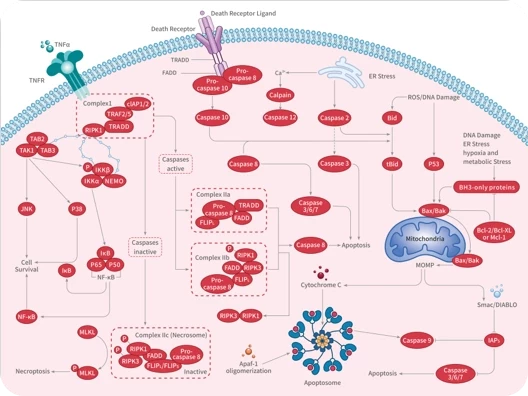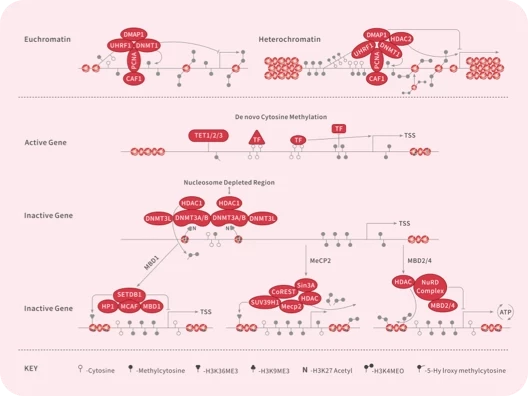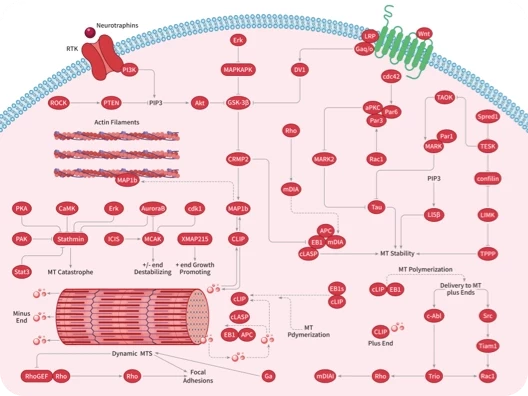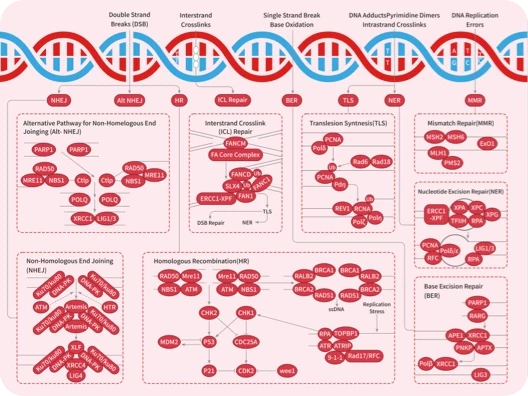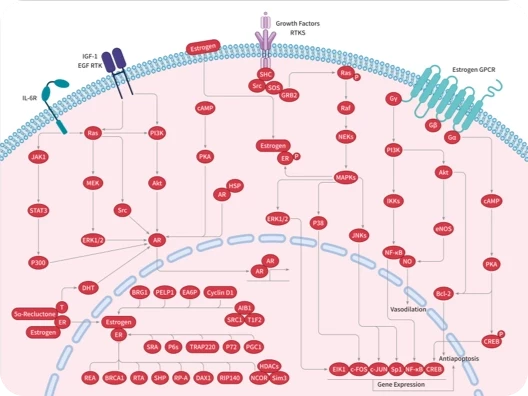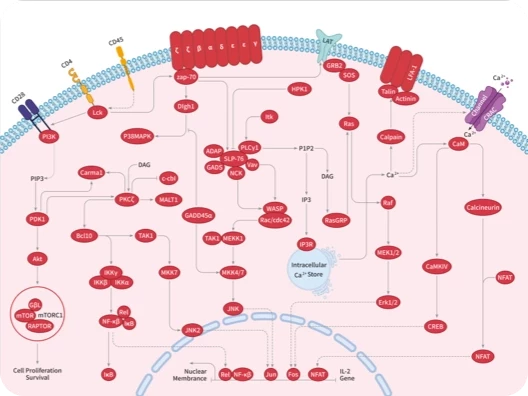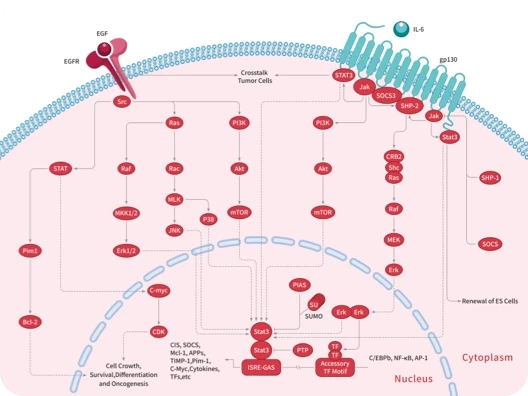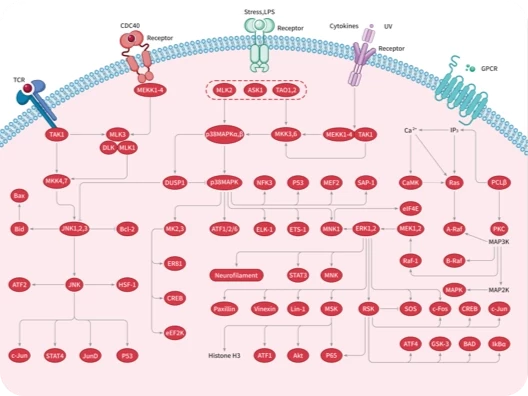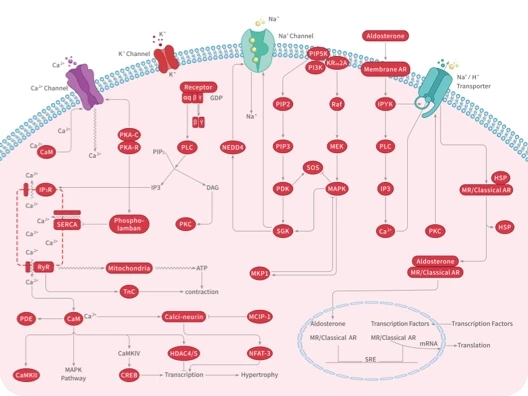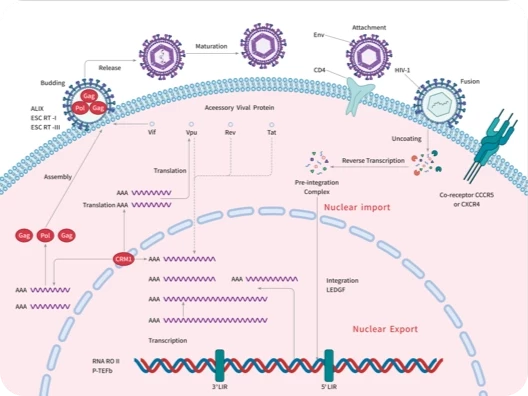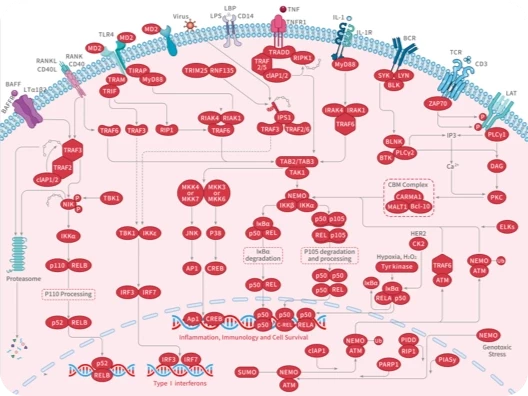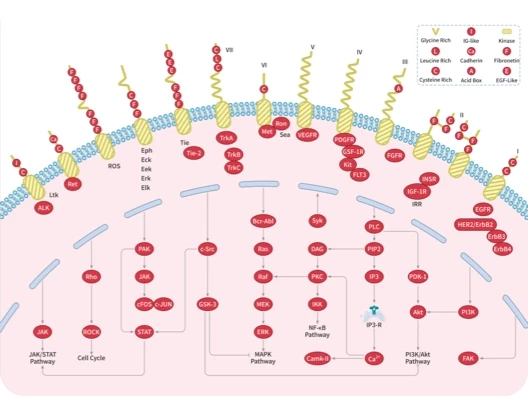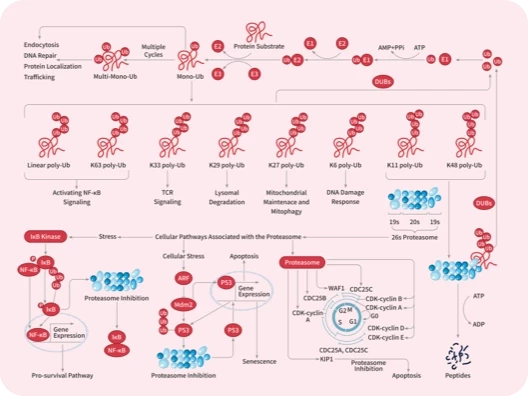- 全部删除
 您的购物车当前为空
您的购物车当前为空
购物车
Angiopoietin 家族 (Angiopoietin)
(64)
Ephrin 家族 (Ephrin Family)
(53)
Insulin-like 生长因子家族 (Insulin-like Growth Factors, IGFs)
(53)
神经营养因子家族 (Neurotrophins)
(108)
纤维生长因子家族 (Fibroblast Growth Factors, FGFs)
(56)
血小板源生长因子 (Platelet-Derived Growth Factors, PDGFs)
(21)
血管内皮生长因子家族 (Vascular Endothelial Growth Factors, VEGFs)
(40)
表皮生长因子家族 (Epidermal Growth Factor Family, EGFs)
(50)
转化生长因子-β 家族 (Transforming Growth Factor-β family, TGF-βs)
(94)
骨形成蛋白家族 (Bone Morphogenetic Proteins, BMPs)
(22)
骨形成蛋白家族 (Bone Morphogenetic Proteins, BMPs)
骨形态发生蛋白(BMPs)是一组生长因子,也称为细胞因子和代谢因子。BMPs最初是因其诱导骨和软骨形成的能力而被发现的,现在被认为构成了一组关键的形态发生信号,协调了整个身体的组织结构。BMP 信号在生理学中的重要功能被 BMP 信号失调在病理过程中的多种作用所强调。癌性疾病通常涉及BMP信号系统的失调。
BMP-4 Protein, Human, Recombinant (E399D)
TMPY-06842
BMP-4 Protein, Human, Recombinant (E399D) is expressed in E. coli expression system. The predicted molecular weight is 13.25 kDa and the accession number is P12644.
- ¥ 1950
规格
数量
BMP-2 Protein, Human, Mouse, Rat, Rhesus, Canine, Recombinant (hFc)
TMPY-00680
BMP-2 Protein, Human, Mouse, Rat, Rhesus, Canine, Recombinant (hFc) is expressed in HEK293 mammalian cells with hFc tag. The predicted molecular weight is 39.5 kDa and the accession number is C8C060.
- ¥ 1350
规格
数量
BMP-2 Protein, Human, Mouse, Rat, Rhesus, Canine, Recombinant
TMPY-01136
BMP-2 Protein, Human, Mouse, Rat, Rhesus, Canine, Recombinant is expressed in E. coli expression system. The predicted molecular weight is 13 kDa and the accession number is C8C060.
- ¥ 1750
规格
数量
BMP-4 Protein, Human, Recombinant (His)
TMPH-01017
BMP-4 Protein, Human, Recombinant (His) is expressed in E. coli expression system with N-6xHis tag. The predicted molecular weight is 15.4 kDa and the accession number is P12644.
- ¥ 1320
规格
数量
BMP-6 Protein, Human, Recombinant (His)
TMPH-01018
BMP-6 Protein, Human, Recombinant (His) is expressed in E. coli expression system with N-6xHis tag. The predicted molecular weight is 18.9 kDa and the accession number is P22004.
- ¥ 1320
规格
数量
BMP-4 Protein, Mouse, Recombinant (rFc)
TMPY-00431
BMP-4 Protein, Mouse, Recombinant (rFc) is expressed in HEK293 mammalian cells with rFc tag. The predicted molecular weight is 40.6 kDa and the accession number is P21275.
- ¥ 1250
规格
数量
Irisin Protein, Human/Mouse/Rat, Recombinant (N-His)
TMPJ-01228
Irisin Protein, Human Mouse Rat, Recombinant (N-His) is expressed in HEK293 mammalian cells with N-6xHis tag. The predicted molecular weight is 18-28 KDa and the accession number is Q8NAU1.
- ¥ 820
规格
数量
Irisin Protein, Human/Mouse/Rat, Recombinant (C-His)
TMPJ-01227
Irisin Protein, Human Mouse Rat, Recombinant (C-His) is expressed in HEK293 mammalian cells with C-6xHis tag. The predicted molecular weight is 20-28 KDa and the accession number is Q8NAU1.
- ¥ 820
规格
数量
BMP-7 Protein, Human, Recombinant
TMPJ-01473
Bone morphogenetic protein 7 (BMP7), also known as osteogenic protein-1 (OP-1) is a member of Transforming growth factor-β (TGF-β) family of proteins. Bone morphogenetic proteins were discovered in 1965 by Marshal Urist, of which BMP7 is of particular interest in this review being a leptin-independent anorexinogen and having role in energy expenditure in the brown adipose tissue, which makes it a potential target for preventing treating obesity. As it has been established that Obesity displays a state of leptin-resistance, thus a protein-like BMP7 which acts through a leptin-independent pathway could give new therapeutic directions.
- ¥ 1970
规格
数量
BMP-2 Protein, Human, Recombinant (His)
TMPH-01014
BMP-2 Protein, Human, Recombinant (His) is expressed in E. coli expression system with N-6xHis tag. The predicted molecular weight is 16.9 kDa and the accession number is P12643.
- ¥ 1320
规格
数量
GDF-11 Protein, Human, Recombinant
TMPJ-00713
Growth differentiation factor 11(GDF-11) is a secreted protein, which belongs to the transforming growth factor beta superfamily. GDF-11 controls anterior-posterior patterning by regulating the expression of Hox genes. The secreted signal acts globally to specify positional identity along the anterior posterior axis during development. GDF11 has been shown to suppress neurogenesis through a pathway similar to that of myostatin, including stopping the progenitor cell-cycle during G-phase. The similarities between GDF11 and myostatin imply a likelihood that the same regulatory mechanisms are used to control tissue size during both muscular and neural development.
- ¥ 1170
规格
数量
BMP3 Protein, Mouse, Recombinant (Myc)
TMPH-02552
Negatively regulates bone density. Antagonizes the ability of certain osteogenic BMPs to induce osteoprogenitor differentitation and ossification.
- ¥ 2290
规格
数量
BMP-4 Protein, Bovine, Recombinant (GST)
TMPH-00228
BMP-4 Protein, Bovine, Recombinant (GST) is expressed in E. coli expression system with N-GST tag. The predicted molecular weight is 40.6 kDa and the accession number is Q2KJH1.
- ¥ 2290
规格
数量
BMP-7 Protein, Human, Recombinant (GST)
TMPH-01019
BMP-7 Protein, Human, Recombinant (GST) is expressed in E. coli expression system with N-GST tag. The predicted molecular weight is 42.7 kDa and the accession number is P18075.
- ¥ 1320
规格
数量
BMP-15 Protein, Human, Recombinant (His & Myc)
TMPH-01013
May be involved in follicular development. Oocyte-specific growth differentiation factor that stimulates folliculogenesis and granulosa cell (GC) growth. BMP-15 Protein, Human, Recombinant (His & Myc) is expressed in E. coli expression system with N-10xHis and C-Myc tag. The predicted molecular weight is 21.4 kDa and the accession number is O95972.
- ¥ 1320
规格
数量
BMP-2 Protein, Danio rerio (zebrafish), Recombinant
TMPY-03297
BMP-2 Protein, Danio rerio (zebrafish), Recombinant is expressed in E. coli expression system. The predicted molecular weight is 13.2 kDa and the accession number is B3DI86.
- ¥ 1750
规格
数量
BMP-5 Protein, Human, Recombinant (hFc)
TMPY-00681
Bone Morphogenetic Protein 5 (BMP-5) is a member of the structurally and functionally related bone morphogenetic proteins (BMPs) which constitute a novel subfamily of the transforming growth factor β (TGF-β) superfamily. In agreement with a possible role in the control of cell death, BMP-5 exhibited a regulated pattern of expression in the interdigital tissue. Transcripts of BMP-5 and BMP-5 protein were abundant within the cytoplasm of the fragmenting apoptotic interdigital cells in a way suggesting that delivery of BMPs into the tissue is potentiated during apoptosis. Gain-of-function experiments demonstrated that BMP-5 has the same effect as other interdigital BMPs inducing apoptosis in the undifferentiated mesoderm and growth in the prechondrogenic mesenchyme. BMP-5 is a member of the 60A subgroup of BMPs, other members of which have been shown to stimulate dendritic growth in central and peripheral neurons. The signaling pathway that mediates the dendrite-promoting activity of BMP-5 may involve binding to BMPR-IA and activation of Smad-1, and relative levels of BMP antagonists such as noggin and follistatin may modulate BMP-5 signaling. Since BMP-5 is expressed at relatively high levels not only in the developing but also the adult nervous system, these findings suggest the possibility that BMP-5 regulates dendritic morphology not only in the developing but also the adult nervous system. BMP-5 may play important roles not only in myocardial differentiation but also in the formation and maintenance of endocardial cushion tissue. Additionally, a high expression level of BMP-5 has been detected in certain tumors of mesenchymal origin.
- ¥ 1350
规格
数量
BMP-7 Protein, Human, Recombinant (His)
TMPH-03819
BMP-7 Protein, Human, Recombinant (His) is expressed in E. coli with N-6xHis. The accession number is P18075.
- ¥ 1320
规格
数量
Irisin Protein, Human/Mouse/Rat, Recombinant (hFc)
TMPJ-01226
Irisin Protein, Human Mouse Rat, Recombinant (hFc) is expressed in HEK293 mammalian cells with C-Fc tag. The predicted molecular weight is 50-60 KDa and the accession number is Q8NAU1.
- ¥ 820
规格
数量
BMP-7 Protein, Human, Recombinant (Active)
TMPH-03820
BMP-7 Protein, Human, Recombinant (Active) is expressed in HEK293 Cells with Tag free. The accession number is P18075.
- ¥ 1770
规格
数量
GDF-10 Protein, Mouse, Recombinant (hFc)
TMPY-01817
BMP-3b GDF-10 is a member of the bone morphogenetic protein (BMP) family and the TGF-beta superfamily. This group of proteins is characterized by a polybasic proteolytic processing site which is cleaved to produce a mature protein containing seven conserved cysteine residues. The members of this family are regulators of cell growth and differentiation in both embryonic and adult tissues. Studies in mice suggest that the protein encoded by this gene plays a role in skeletal morphogenesis. In the bone morphogenetic cascade, cartilage differentiation, hypertrophy, and cell death are followed by bone formation. In this regard, all BMPs are cartilage morphogenetic proteins since cartilage is formed first. An overexpression or dysregulation of BMP pathways may lead to heterotopic bone formation or fibrodysplasia ossificans progressiva (FOP). BMPs have been implicated in FOP. The pioneering work of Sakou has implicated BMP-3b GDF-10 in ossification of the posterior longitudinal ligament of the spine in Japanese patients. The BMP-specific antagonists such as noggin or chordin might be used therapeutically in clinical conditions with pathologically excessive bone formation. The osteoinductive capacity of BMPs has been demonstrated in preclinical models, and the efficacy of BMPs for the treatment of orthopaedic patients is now being evaluated in clinical trials. It was suggested that further progress in the clinical application of the BMP-3b GDF-10 will depend upon the development of carriers with ideal release kinetics for the delivery of the BMPs.
- ¥ 3820
规格
数量
BMP-3 Protein, Human, Recombinant (His)
TMPH-01015
Growth factor of the TGF-beta superfamily that plays an essential role in developmental process by inducing and patterning early skeletal formation and by negatively regulating bone density. Antagonizes the ability of certain osteogenic BMPs to induce osteoprogenitor differentitation and ossification. Initiates signaling cascades by associating with type II receptor ACVR2B to activate SMAD2-dependent and SMAD-independent signaling cascades including TAK1 and JNK pathways. BMP-3 Protein, Human, Recombinant (His) is expressed in E. coli expression system with N-6xHis tag. The predicted molecular weight is 16.4 kDa and the accession number is P12645.
- ¥ 1320
规格
数量
转到第1页
/ 1 页












